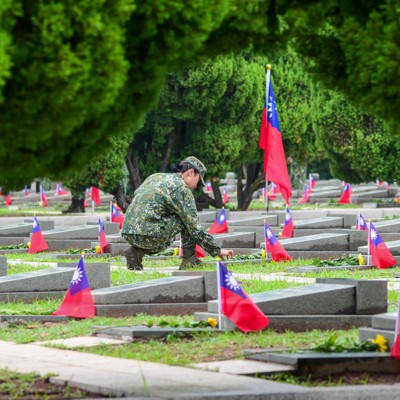As China applies increasing military pressure against Taiwan, it’s worth considering an earlier era when conditions were much worse. In the fall of 1958, four countries—United States, Soviet Union, People’s Republic of China and the Republic of China (Taiwan)—found themselves on the brink of nuclear war. The incident, which would later be known as the second Taiwan Strait Crisis, led to a rupture in Sino-Soviet relations and altered the trajectory of the Cold War. Revisiting it reminds us of an element of deterrence that is getting short shrift today.
The crisis began on Aug. 23, 1958, when China began shelling the offshore islands known as Quemoy (Jinmen, 金門, in Mandarin Chinese). At the time, President Eisenhower and his family were preparing for a vacation in Newport, Rhode Island, and the Navy had set up a special office for the president at the Naval War College—in Building 10, today home to the school’s museum.
In early September, Eisenhower summoned John Foster Dulles to fly up from Washington and to meet him at the U.S. naval base at Newport. According to White House records, Dulles arrived in Newport and on Sept. 4 “conferred with the President on the situation at Quemoy and Formosa [Taiwan] from 10:29am until 12:10pm.”
Also attending the meeting were Joseph Greene, special assistant to the Secretary of State, Brig. Gen. Andrew J. Goodpaster, military adviser to the president; James Hagerty, the White House press secretary; and Captain E.P. Aurand, Eisenhower’s naval aide. Later that day, Dulles issued the Newport statement, in which he asserted eight points regarding America’s response to Chinese aggression in the Taiwan Strait.
The statement emphasized that the U.S. was “bound by treaty” to help to defend Taiwan—the main island and the Pescadores [Penghu] Islands—from “armed attack,” while the Formosa Resolution of 1955 granted the President additional powers to protect “related positions,” such as Quemoy and Matsu.
At its core, therefore, the Newport statement was an articulation of America’s deterrence posture in the Taiwan Strait at a critical point in history. Dulles later told U.K. Prime Minister Harold Macmillan that “the firm position we are taking will in fact deter reckless Communist action,” although he acknowledged that it might provoke an overreaction or miscalculation by Mao Zedong or his primary backer, Nikita Khrushchev.
To appreciate the deterrent value of the Newport statement, it is useful to examine it through the lens of the three key elements that underpin the concept: capability, credibility and communication. On the capability front, the U.S. had substantial military assets on Taiwan, including conventional and nuclear munitions—of which Beijing was aware—and contemplated using nuclear weapons to achieve a decisive outcome in and around Quemoy if necessary.
On the credibility front, President Eisenhower had already demonstrated in the first Taiwan Strait Crisis (1954-55) that he was willing to go to the brink to defend Taiwan. In addition, the Newport statement reiterated the key point of the Formosa Resolution, which was that it was in America’s “vital interest” that a government friendly to the United States retain control over Taiwan.
On the communication front, Dulles delivered his statement clearly to the international media, which published it widely. However, some critics argued that Dulles’ occasional conditional and conciliatory phrases—such as the “earnestly hope” plea in point seven—weakened American credibility and resolve. An editorial in the Washington Post and Times Herald, for example, said the Newport statement had correctly avoided “the stridency of some military commanders in this delicate situation,” but it had fallen “short of the unqualified assertion necessary to give it backbone.”
However, another way of viewing the Newport statement notes Dulles’ reliance on a fourth element of deterrence known as assurance. In his book Arms and Influence, Thomas Schelling wrote that “any coercive threat requires corresponding assurances; the object of a threat is to give somebody a choice.” In other words, as Schelling describes, in a scenario where a deterrer announces “one more step and I shoot,” the implicit assumption is that by not taking that extra step, one will not be shot.
Dulles was arguably following this logic, intuitively, due to his legal training or because of other factors, when he decided to add conditional and conciliatory phrases to his statement. He wanted to make it clear to his Chinese audience what the United States was willing to do, in the face of adverse scenarios, but he also wanted to give China several “off ramps” in which its national interests could be preserved, and its face—national and individual honor and pride—could be salvaged.
The 1958 episode provides lessons today because Taiwan continues to be the primary flashpoint in the U.S.-China relationship and a potential cause of major-power war. Unfortunately, recent actions by both Beijing and Washington suggest that the assurance dimension of deterrence has degraded. For example, China regularly launches aggressive and coercive military exercises against Taiwan, while Washington hints through official documents and actions that it might be willing to acknowledge Taiwan’s de jure sovereign status. These actions and others suggest that deterrence dynamics in and around the Taiwan Strait are weakening, which means the chances of a devastating war are correspondingly rising.
The 1958 Taiwan Strait crisis and its associated Newport statement offer a way to bolster deterrence and stabilize today’s situation. The episode is a reminder that assurance—the implied promise that the person or country being deterred will not suffer existential loss or harm—is as relevant today as it was then. In practical terms, this means the United States would not seek to change Taiwan’s status or recognize it as a de jure sovereign state, with the implied assumption—per the Taiwan Relations Act—that Beijing will not attempt to “determine the future of Taiwan by other than peaceful means, including by boycotts or embargoes…”
In addition, the growing power imbalance between Taipei and Beijing requires that the U.S. continue to restore and to build the core elements of deterrence—credible and overwhelming capabilities in the Taiwan area, backed by unquestioned resolve—that would reduce China’s temptation to take unilateral action. This deterrence dynamic, including the assurance element, has maintained peace for more than seven decades. Its successful track record provides a strong case as to why it should be maintained.
Paul Smith is professor of national security affairs, Naval War College, and author of the forthcoming book America’s China Gamble: Six Phases and Our Perilous Future (Edward Elgar Publishing). The views expressed here are his own.
Read the full article here








Leave a Reply